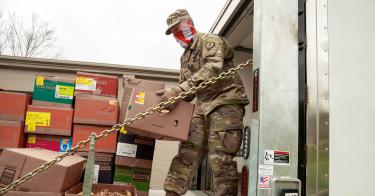The Trump administration’s 2017 National Security Strategy differed markedly from that of its predecessor. The greatest difference was a shift in focus, now concentrated more heavily on competing with China and Russia.
Perhaps the most pronounced change came in the view of China. The Obama administration’s final 2015 National Security Strategy had set the goal of a “rise of a stable, peaceful, and prosperous China.” That goal was deep-sixed in the new administration’s strategy.
Another key difference: the new strategy articulated a more direct link between America’s security and its economic prosperity.
Reviews of the strategy focused on these novelties and were largely favorable. Little noticed was the prominence given in the strategy to the threat from pandemics.
The Obama administration’s 2015 strategy made little mention of pandemics. By way of contrast, the 2017 strategy dedicated an entire section to dealing with biothreats and pandemics, putting them on the same structural level as strengthening border control and immigration policy in the document.
The prominence given pandemics makes a statement Tuesday by Rep. Ro Khanna, D-Calif., puzzling. Talking with reporters, he argued, "progressives need to make the case for a much savvier, 21st Century national security strategy in light of COVID-19." Yet the current strategy clearly views the threat from pandemics nearly as seriously as President George W. Bush did when he became convinced America was unprepared and directed his administration to develop a series of pandemic influenza strategies and plans in 2005.
Trump’s security strategy presciently declares “naturally emerging outbreaks of viruses such as Ebola and SARS, as well as the deliberate 2001 anthrax attacks in the United States, demonstrated the impact of biological threats on national security by taking lives, generating economic losses, and contributing to a loss of confidence in government institutions.”
To deal with these threats, the strategy called for the ability to “detect and contain biothreats at their source,” to “support biomedical innovation,” and to “improve emergency response.” To contain threats early, the strategy describes the need to “work with other countries to detect and mitigate outbreaks early.”
Unfortunately, because of China's intransigence, this part of the strategy was impossible to carry out. As the New York Times reported on February 7, “for more than a month, the Centers for Disease Control and Prevention has been offering to send a team of experts to China to observe its coronavirus outbreak and help if it can.” That offer was consistently rebuffed by Beijing.
The federal government has also been applying resources to the threat. In 2020 the administration requested $509 million for the CDC’s Center for Emerging and Zoonotic Infectious diseases, a key element of the U.S. response to new diseases.
Washington naturally re-evaluates America’s security priorities after any major emergency. When a doomsday cult named Aum Shinrikyo attacked a Tokyo subway in 1995 with nerve gas, Congress and the administration moved swiftly to spend millions to better protect U.S. infrastructure. After the 9/11 attacks, Congress created the Transportation Security Administration to rectify airport security procedures. Anthrax letters mailed throughout the country in 2001 resulted in major changes in the country’s bio-weapon response capabilities, with billions of dollars spent on new detectors and protections. After the 2005 Hurricane Katrina, Congress reorganized FEMA.
Given COVID-19’s global disruptions and the devastation to our economy, changes are a given. For example, federal OSHA guidelines that place responsibility on hospitals to provide their workers with the necessary personnel protective equipment might be augmented with larger regional and national stockpiles.
Even though the Trump administration recognized the danger from pandemics, our country is still experiencing untold turmoil. Balancing and prioritizing future risks, just like deciding what type and how much insurance to buy, is difficult work.
Generals are often accused of “fighting the last war,” meaning they prepare for wars similar to ones most recently fought, rather than preparing for a different type of warfare that the future will bring. The next security challenge America faces will likely take a still different form. Working together, Congress, states and administration will need to effectively address the deficiencies uncovered in this emergency while being careful not to undermine other areas of national security.
This piece originally appeared in Real Clear Defense



